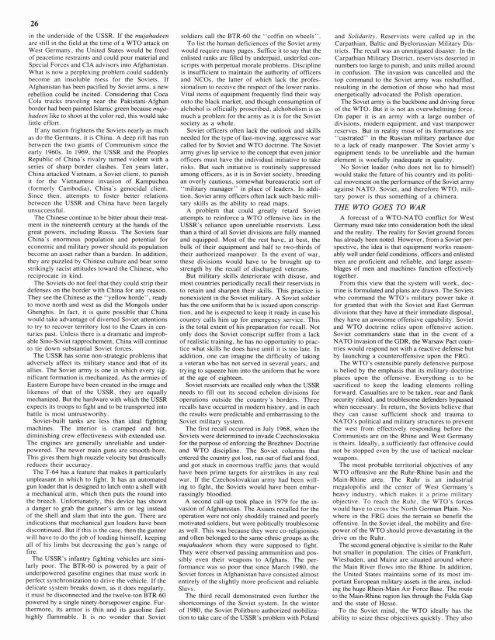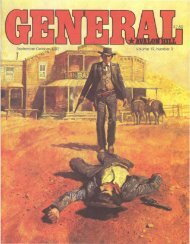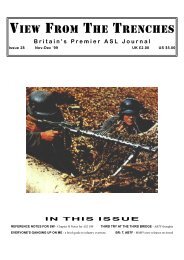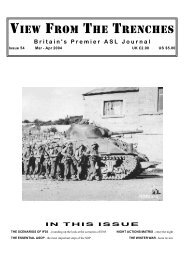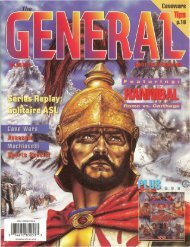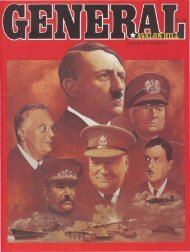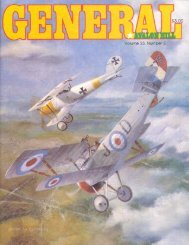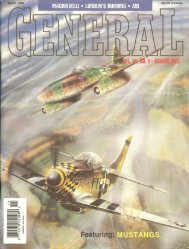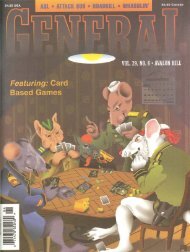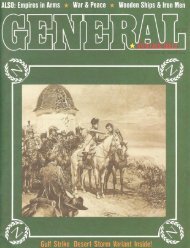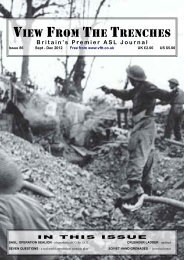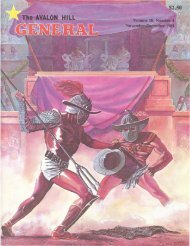Create successful ePaper yourself
Turn your PDF publications into a flip-book with our unique Google optimized e-Paper software.
in the underside of the USSR. If the mujahadeen<br />
are still in the field at the time of a WTO attack on<br />
West Germany, the United States would be freed<br />
of peacetime restraints and could pour material and<br />
Special Forces and CIA advisors into Afghanistan.<br />
What is now a perplexing problem could suddenly<br />
become an insoluble mess for the Soviets. If<br />
Afghanistan has been pacified by Soviet arms, a new<br />
rebellion could be incited. Considering that Coca<br />
Cola trucks traveling near the Pakistani-Afghan<br />
border had been painted Islamic green because muja-<br />
hadeen like to shoot at the color red, this would take<br />
little effort.<br />
If any nation frightens the Soviets nearly as much<br />
as do the Germans, it is China. A deep rift has run<br />
between the two giants of Communism since the<br />
early 1960s. In 1969, the USSR and the Peoples<br />
Republic of China's rivalry turned violent with a<br />
series of sharp border clashes. Ten years later,<br />
China attacked Vietnam, a Soviet client, to punish<br />
it for the Vietnamese invasion of Kampuchea<br />
(formerly Cambodia), China's genocidal client.<br />
Since then, attempts to foster better relations<br />
between the USSR and China have been largely<br />
unsuccessful.<br />
<strong>The</strong> Chinese continue to be bitter about their treat-<br />
ment in the nineteenth century at the hands of the<br />
great powers, including Russia. <strong>The</strong> Soviets fear<br />
China's enormous population and potential for<br />
economic and military power should its population<br />
become an asset rather than a burden. In addition,<br />
they are puzzled by Chinese culture and bear some<br />
strikingly racist attitudes toward the Chinese, who<br />
reciprocate in kind.<br />
<strong>The</strong> Soviets do not feel that they could strip their<br />
defenses on the border with China for any reason.<br />
<strong>The</strong>y see the Chinese as the "yellow horde", ready<br />
to move north and west as did the Mongols under<br />
Ghenghis. In fact, it is quite possible that China<br />
would take advantage of diverted Soviet attentions<br />
to try to recover territory lost to the Czars in cen-<br />
turies past. Unless there is a dramatic and improb-<br />
able Sino-Soviet rapprochement, China will continue<br />
to tie down substantial Soviet forces.<br />
<strong>The</strong> USSR has some non-strategic problems that<br />
adversely affect its military stance and that of its<br />
allies. <strong>The</strong> Soviet army is one in which every sig-<br />
nificant formation is mechanized. As the armies of<br />
Eastern Europe have been created in the image and<br />
likeness of that of the USSR, they are equally<br />
mechanized. But the hardware with which the USSR<br />
expects its troops to fight and to be transported into<br />
battle is most untrustworthy.<br />
Soviet-built tanks are less than ideal fighting<br />
machines. <strong>The</strong> interior is cramped and hot,<br />
diminishing crew effectiveness with extended use.<br />
<strong>The</strong> engines are generally unreliable and under-<br />
powered. <strong>The</strong> newer main guns are smooth-bore.<br />
This gives them high muzzle velocity but drastically<br />
reduces their accuracy.<br />
<strong>The</strong> T-64 has a feature that makes it particularly<br />
unpleasant in which to tight. It has an automated<br />
gun loader that is designed to latch onto a shell with<br />
a mechanical arm, which then puts the round into<br />
the breech. Unfortunately, this device has shown<br />
a danger to grab the gunner's arm or leg instead<br />
of the shell and slam that into the gun. <strong>The</strong>re are<br />
indications that mechanical gun loaders have been<br />
discontinued. But if this is the case, then the gunner<br />
will have to do the job of loading himself, keeping<br />
all of his limbs but decreasing the gun's range of<br />
fire.<br />
<strong>The</strong> USSR's infantry fighting vehicles are simi-<br />
larly poor. <strong>The</strong> BTR-60 is powered by a pair of<br />
underpowered gasoline engines that must work in<br />
perfect synchronization to drive the vehicle. If the<br />
delicate system breaks down, as it does regularly,<br />
it must be disconnected and the twelve-ton BTR-60<br />
powered by a single ninety-horsepower engine. Fur-<br />
thermore, its armor is thin and its gasoline fuel<br />
highly flammable. It is no wonder that Soviet<br />
soldiers call the BTR-60 the "coffin on wheels".<br />
To list the human deficiences of the Soviet army<br />
would require many pages. Suffice it to say that the<br />
enlisted ranks are filled by underpaid, underfed con-<br />
scripts with perpetual morale problems. Discipline<br />
is insufficient to maintain the authority of officers<br />
and NCOs, the latter of which lack the profes-<br />
sionalism to receive the respect of the lower ranks.<br />
Vital items of equipment frequently find their way<br />
onto the black market, and though consumption of<br />
alchohol is officially proscribed, alchoholism is as<br />
much a problem for the army as it is for the Soviet<br />
society as a whole.<br />
Soviet officers often lack the outlook and skills<br />
needed for the type of fast-moving, aggressive war<br />
called for by Soviet and WTO doctrine. <strong>The</strong> Soviet<br />
army gives lip service to the concept that even junior<br />
officers must have the individual initiative to take<br />
risks. But such initiative is routinely suppressed<br />
among officers, as it is in Soviet society, breeding<br />
an overly cautious, somewhat bureaucratic sort of<br />
"military manager" in place of leaders. In addi-<br />
tion, Soviet army officers often lack such basic mili-<br />
tary skills as the ability to read maps.<br />
A problem that could greatly retard Soviet<br />
attempts to reinforce a WTO offensive lies in the<br />
USSR's reliance upon unreliable reservists. Less<br />
than a third of all Soviet divisions are fully manned<br />
and equipped. Most of the rest have, at best, the<br />
bulk of their equipment and half to two-thirds of<br />
their authorized manpower. In the event of war,<br />
these divisions would have to be brought up to<br />
strength by the recall of discharged veterans.<br />
But military skills deteriorate with disuse, and<br />
most countries periodically recall their reservists in<br />
to retain and sharpen their skills. This practice is<br />
nonexistent in the Soviet military. A Soviet soldier<br />
has the one uniform that he is issued upon conscrip-<br />
tion, and he is expected to keep it ready in case his<br />
country calls him up for emergency service. This<br />
is the total extent of his preparation for recall. <strong>No</strong>t<br />
only does the Soviet conscript suffer from a lack<br />
of realistic training, he has no opportunity to prac-<br />
tice what skills he does have until it is too late. In<br />
addition, one can imagine the difficulty of taking<br />
a veteran who has not served in several years, and<br />
trying to squeeze him into the uniform that he wore<br />
at the age of eighteen.<br />
Soviet reservists are recalled only when the USSR<br />
needs to fill out its second echelon divisions for<br />
operations outside the country's borders. Three<br />
recalls have occurred in modern history, and in each<br />
the results were predictable and embarrassing to the<br />
Soviet military system.<br />
<strong>The</strong> first recall occurred in July 1968, when the<br />
Soviets were determined to invade Czechoslovakia<br />
for the purpose of enforcing the Brezhnev Doctrine<br />
and WTO discipline. <strong>The</strong> Soviet columns that<br />
entered the country got lost, ran out of fuel and food,<br />
and got stuck in enormous traffic jams that would<br />
have been prime targets for airstrikes in any real<br />
war. If the Czechoslovakian army had been will-<br />
ing to fight, the Soviets would have been embar-<br />
rassingly bloodied.<br />
A second call-up took place in 1979 for the in-<br />
vasion of Afghanistan. <strong>The</strong> Asians recalled for the<br />
operation were not only shoddily trained and poorly<br />
motivated soldiers, but were politically troublesome<br />
as well. This was because they were co-religionists<br />
and often belonged to the same ethnic groups as the<br />
mujahadeen whom they were supposed to fight.<br />
<strong>The</strong>y were observed passing ammunition and pos-<br />
sibly even their weapons to Afghans. <strong>The</strong> per-<br />
formance was so poor that since March 1980, the<br />
Soviet forces in Afghanistan have consisted almost<br />
entirely of the slightly more proficient and reliable<br />
Slavs.<br />
<strong>The</strong> third recall demonstrated even further the<br />
shortcomings of the Soviet system. In the winter<br />
of 1980, the Soviet Politburo authorized mobiliza-<br />
tion to take care of the USSR's problem with Poland<br />
and Solidarity. Reservists were called up in the<br />
Carpathian, Baltic and Byelorussian Military Dis-<br />
tricts. <strong>The</strong> recall was an unmitigated disaster. In the<br />
Carpathian Military District, reservists deserted in<br />
numbers too large to punish, and units milled around<br />
in confusion. <strong>The</strong> invasion was cancelled and the<br />
top command to the Soviet army was reshuffled,<br />
resulting in the demotion of those who had most<br />
energetically advocated the Polish operation.<br />
<strong>The</strong> Soviet army is the backbone and driving force<br />
of the WTO. But it is not an overwhelming force.<br />
On paper it is an army with a large number of<br />
divisions, modern equipment, and vast manpower<br />
reserves. But in reality most of its formations are<br />
"castrated" in the Russian military parlance due<br />
to a lack of ready manpower. <strong>The</strong> Soviet army's<br />
equipment tends to be unreliable and the human<br />
element is woefully inadequate in quality.<br />
<strong>No</strong> Soviet leader (who does not lie to himself)<br />
would stake the future of his country and its politi-<br />
cal movement on the performance of the Soviet army<br />
against NATO. Soviet, and therefore WTO, mili-<br />
tary power is thus something of a chimera.<br />
THE WTO GOES TO WAR<br />
A forecast of a WTO-NATO conflict for West<br />
Germany must take into consideration both the ideal<br />
and the reality. <strong>The</strong> reality for Soviet ground forces<br />
has already been noted. However, from a Soviet per-<br />
spective, the idea is that equipment works reason-<br />
ably well under field conditions, officers and enlisted<br />
men are proficient and reliable, and large assem-<br />
blages of men and machines function effectively<br />
together.<br />
From this view that the system will work, doc-<br />
trine is formulated and plans are drawn. <strong>The</strong> Soviets<br />
who command the WTO's military power take it<br />
for granted that with the Soviet and East German<br />
divisions that they have at their immediate disposal,<br />
they have an awesome offensive capability. Soviet<br />
and WTO doctrine relies upon offensive action.<br />
Soviet commanders state that in the event of a<br />
NATO invasion of the GDR, the Warsaw Pact coun-<br />
tries would respond not with a reactive defense but<br />
by launching a counteroffensive upon the FRG.<br />
<strong>The</strong> WTO's ostensible purely defensive purpose<br />
is belied by the emphasis that its military doctrine<br />
places upon the offensive. Everything is to be<br />
sacrificed to keep the leading elements rolling<br />
forward. Casualties are to be taken, rear and flank<br />
security risked, and troublesome defenders bypassed<br />
when necessary. In return, the Soviets believe that<br />
they can cause sufficient shock and trauma to<br />
NATO's political and military structures to prevent<br />
the west from effectively responding before the<br />
Communists are on the Rhine and West Germany<br />
is theirs. Ideally, a sufficiently fast offensive could<br />
not be stopped even by the use of tactical nuclear<br />
weapons.<br />
<strong>The</strong> most probable territorial objectives of any<br />
WTO offensive are the Ruhr-Rhine basin and the<br />
Main-Rhine area. <strong>The</strong> Ruhr is an industrial<br />
megalopolis and the center of West Germany's<br />
heavy industry, which makes it a prime military<br />
objective. To reach the Ruhr, the WTO's forces<br />
would have to cross the <strong>No</strong>rth German Plain. <strong>No</strong>-<br />
where in the FRG does the terrain so benefit the<br />
offensive. In the Soviet ideal, the mobility and fire-<br />
power of the WTO should prove devastating in the<br />
drive on the Ruhr.<br />
<strong>The</strong> second general objective is similar to the Ruhr<br />
but smaller in population. <strong>The</strong> cities of Frankfurt,<br />
Wiesbaden, and Mainz are situated around where<br />
the Main River flows into the Rhine. In addition,<br />
the United States maintains some of its most im-<br />
portant European military assets in the area, includ-<br />
ing the huge Rhein-Main Air Force Base. <strong>The</strong> route<br />
to the Main-Rhine region lies through the Fulda Gap<br />
and the state of Hesse.<br />
To the Soviet mind, the WTO ideally has the<br />
ability to seize these objectives quickly. <strong>The</strong>y also


